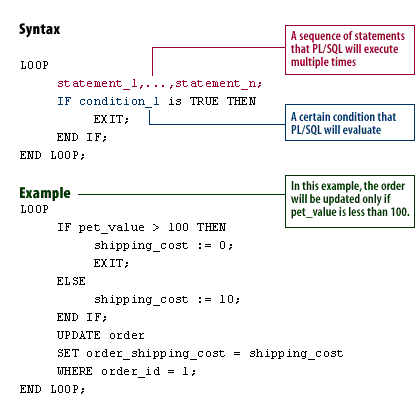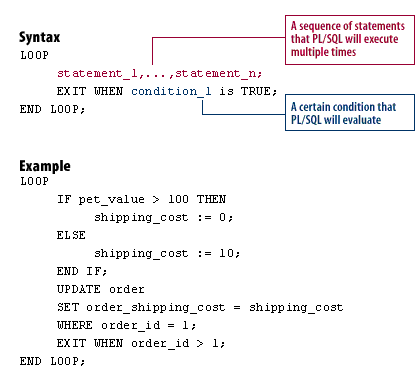| Lesson 4 | What are loops? |
| Objective | Determine how to begin and end a simple loop within a PL/SQL block. |
Programming PL/SQL Loops
A loop is a powerful way of building iterative logic. This lesson introduces you to loops.PL/SQL LOOP Statement
The
LOOP statement allows you to build iterative controls within your PL/SQL block. LOOP allows you to repeat a sequence of statements. The statements to be repeated are placed between the keywords LOOP and END-LOOP. The sequence of statements is executed, and then the control resumes at the top of the loop.

LOOP statement_1, ..., statement_n END LOOP;Example:
LOOP
IF pet_value > 100 THEN
shipping_cost := 0 ;
END IF;
UPDATE order
SET order_shippping_cost = shipping_cost
WHERE order_id =1;
END LOOP;
PL SQL Loop: A sequence of statement that PL/SQL will execute multiple times.
If further processing is undesirable or impossible, you can use the
EXIT statement to exit the loop.
There are two forms of EXIT statements: EXIT and EXIT-WHEN.
EXIT
The
The
EXIT statement forces a loop to complete unconditionally.
When an EXIT statement is encountered, the loop completes immediately and control passes to the next statement.The
EXIT statement must always be placed within a loop. You cannot use this statement to complete a PL/SQL block.

LOOP
statement_1,...,statement_n;
IF condition_1 is TRUE THEN
EXIT
END IF;
END LOOP;
Oracle PL/SQL Best Practices
EXIT-WHEN
The
EXIT-WHEN statement allows a loop to complete conditionally. When the EXIT statement is encountered, the condition in the WHEN clause is evaluated. If the condition evaluates to TRUE, the loop completes and control passes to the next statement after the loop. The EXIT-WHEN statement replaces a simple IF statement.

LOOP statement_1,...,statement_n; EXIT WHEN condition_1 is TRUE; END LOOP;
Identifying Control Structures
Click the link below to learn about PL/SQL control structures.
Identifying Control Structures
In the next lesson, you will observe the structure of
Identifying Control Structures
In the next lesson, you will observe the structure of
FOR and WHILE loops.